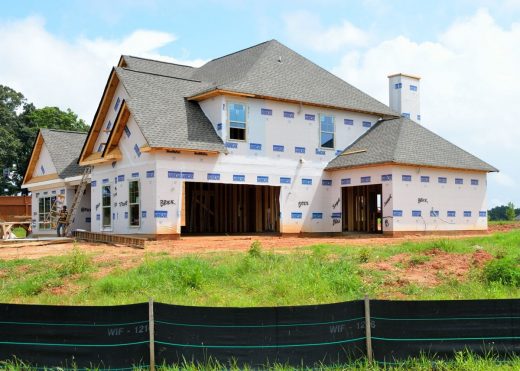Modern energy-efficient residential spaces, Building design, Home architecture
Modern Energy-Efficient Residential Spaces
22 August 2024
How Modern Architecture is Shaping Energy-Efficient Residential Spaces
Modern architecture is increasingly focused on energy efficiency, reflecting a shift towards sustainable living. This transformation is not just about aesthetics but also about designing homes that minimise energy consumption and reduce environmental impact. Architects and designers are now integrating advanced materials and technologies into residential spaces to make homes more energy-efficient, without compromising on comfort or style.
One of the key elements in this shift is the use of innovative insulation methods, particularly in areas like the loft, which can significantly affect a home’s thermal performance. Proper insulation not only helps maintain indoor temperatures but also reduces the reliance on heating and cooling systems, thereby lowering energy bills.
The Role of Insulation in Energy-Efficient Homes
Insulation plays a critical role in modern, energy-efficient architecture. It acts as a barrier to heat flow, keeping your home warm in the winter and cool in the summer. Without adequate insulation, much of the energy used to heat or cool a home would be wasted, leading to higher energy bills and a larger carbon footprint.
One of the most effective ways to improve a home’s energy efficiency is by insulating the loft. Heat rises, and without proper loft insulation, it escapes through the roof. This loss can account for up to 25% of the total heat lost in a home. By using quality loft insulation, homeowners can create a more stable indoor environment, reduce energy consumption, and save money in the long term.
Loft insulation boards are particularly popular due to their efficiency and ease of installation. These boards can be cut to fit specific spaces, ensuring that even awkward areas are well-insulated. They provide a robust solution to prevent heat loss, contributing significantly to the overall energy efficiency of the home.
Advanced Materials in Modern Architecture
The materials used in modern architecture are increasingly chosen for their energy-saving properties. Traditional building materials are being replaced or supplemented with advanced alternatives that offer better insulation, lower thermal conductivity, and improved durability.
For example, in addition to traditional fibreglass, materials like PIR (Polyisocyanurate) boards are gaining popularity. PIR boards are known for their high insulating value, which means they provide excellent thermal resistance with less material. This makes them ideal for use in areas with space constraints, such as in the roof or under the floor. By incorporating these materials, architects can design homes that are not only more energy-efficient but also more compact and flexible.
These advancements in materials are helping to reduce the overall energy demand of homes, making them more sustainable. As a result, homeowners can benefit from lower energy costs and a smaller environmental footprint, while still enjoying modern, comfortable living spaces.
The Importance of Sustainable Design
Sustainable design is at the heart of modern architecture. This approach considers the entire lifecycle of a building, from construction to demolition, with a focus on minimising environmental impact. By using sustainable practices and materials, architects can create homes that are not only energy-efficient but also environmentally responsible.
Incorporating features such as high-performance insulation, energy-efficient windows, and renewable energy systems is now standard practice in sustainable design. These elements work together to reduce a home’s energy consumption and carbon emissions. For instance, a well-insulated home requires less heating in the winter, which means less reliance on fossil fuels and lower greenhouse gas emissions.
Moreover, sustainable design also considers the health and well-being of the occupants. This includes ensuring good indoor air quality, using non-toxic materials, and maximising natural light. All these factors contribute to creating a healthier living environment, which is just as important as energy efficiency in modern residential architecture.
Enhancing Loft Insulation for Maximum Efficiency
Loft insulation is one of the most cost-effective ways to improve a home’s energy efficiency. However, to achieve maximum efficiency, it’s important to choose the right type of insulation and ensure it’s properly installed. There are various options available, including rolls, batts, and boards, each with its own advantages.
Loft insulation boards are particularly effective for their durability and high thermal resistance. They are easy to install, especially in loft spaces that are used for storage or other purposes. These boards can be laid between the rafters or over the floor, depending on the design of the loft and the desired insulation level. By investing in quality loft insulation boards, homeowners can significantly reduce heat loss and improve the overall energy performance of their homes.
If you’re considering upgrading your loft insulation, it’s worth taking the time to explore loft insulation products at Trade Insulations. They offer a range of high-quality products designed to meet the specific needs of modern homes. With the right insulation, you can create a more energy-efficient, comfortable, and sustainable living space.
The Impact of Energy-Efficient Architecture on Living Costs
Energy-efficient architecture has a direct and substantial impact on reducing living costs. As energy prices continue to rise, the need for homes that consume less energy has never been more critical. By integrating energy-efficient designs and materials, homeowners can significantly reduce their utility bills, making energy-efficient homes a smart long-term investment.
For instance, a well-insulated home requires less energy to maintain comfortable indoor temperatures, which leads to lower heating and cooling costs. In many cases, the savings on energy bills can offset the initial cost of installing advanced insulation materials, like loft insulation boards, within just a few years. Additionally, homes with high energy efficiency ratings often have higher property values, as they are increasingly sought after by eco-conscious buyers who are willing to pay a premium for lower running costs and a reduced environmental impact.
The reduction in energy consumption also has broader economic benefits. Lower energy demand can lead to decreased reliance on non-renewable energy sources, contributing to greater energy security and stability in energy markets. In the long run, this shift towards energy-efficient homes can help mitigate the economic impact of energy price fluctuations, benefiting both individual homeowners and the economy as a whole.
How Technology is Enhancing Energy Efficiency
Advancements in technology are playing a crucial role in enhancing energy efficiency in modern homes. Smart home systems, energy-efficient appliances, and renewable energy technologies are just a few examples of how technology is being leveraged to reduce energy consumption and improve the sustainability of residential spaces.
Smart home systems, for instance, allow homeowners to monitor and control their energy use more effectively. These systems can automate heating and cooling, adjusting the temperature based on the time of day, occupancy, or even weather conditions. By optimising energy use in real-time, smart home technologies can reduce unnecessary energy consumption, further lowering utility bills and enhancing the overall efficiency of the home.
Energy-efficient appliances, such as high-efficiency boilers, LED lighting, and low-energy household devices, are also becoming standard in modern homes. These appliances use less energy to perform the same tasks as their traditional counterparts, contributing to lower energy bills and a reduced environmental footprint.
In addition to these technologies, the integration of renewable energy sources, such as solar panels or ground-source heat pumps, is becoming increasingly common. These systems generate clean, renewable energy on-site, reducing reliance on grid electricity and further lowering a home’s carbon footprint. As the cost of renewable energy technologies continues to decrease, more homeowners are adopting these systems, making energy-efficient homes more accessible and affordable.
Comments on this guide to Modern energy-efficient residential spaces article are welcome.
Building Energy
Property Energy
UK sustainable property gain, energy prices crisis
UK Grants to boost energy efficiency and reduce energy bills
Solar energy and financial savings
The benefits of renewable energy for families
Eco Architecture
Contemporary Green Architecture Design
Comments / photos for the Building or Adapting a Home: 6 Key Things to Have in Mind page welcome







